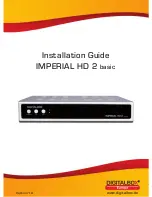
9
DVB-S Receiver
GB
Proper location
Place the receiver on a flat, hard surface.
• Avoid proximity to:
- Heat sources, such as heating elements
- Open flames, such as candles
- Devices with strong magnetic fields, such as speakers
- Do not place any objects filled with water, such as vases, on top of the receiver.
• Avoid direct sunlight and locations with unusually high levels of dust.
• Never cover the ventilation slots. Allow proper airflow to the receiver.
• Do not place heavy objects on top of the receiver.
• Moving the receiver from a cold environment to a hot environment could result in
moisture condensation inside the receiver. In this case, wait approximately one hour
before operating the receiver.
• Lay the mains cable and antenna cable where they cannot be walked on or tripped over.
Proper handling of batteries
• Batteries may contain toxic substances. Keep all batteries out of the reach of children.
Batteries are a choking hazard for children. If a battery is swallowed, seek medical
assistance immediately.
• Battery leakage may damage the remote control unit. Remove the batteries from the
remote control unit if the receiver is unused for extended periods of time.
• Batteries may contain toxic substances. Therefore, always dispose of batteries in
compliance with the applicable legal regulations/environmental standards. Never
dispose of batteries along with normal household waste.
• Never expose batteries to open flames or high heat, as this could result in explosion.
• Always use the same battery type for replacements..
3.2 Meaning of safety notices
This user guide contains the following categories of safety notices:
Danger!
Safety notices with the word DANGER indicate possible personal injury.
Warning!
Safety notices with the word WARNING indicate possible damage to property or the
environment.
These notices contain specific information for efficient use of the receiver.
3. SAFETY WARNING
























